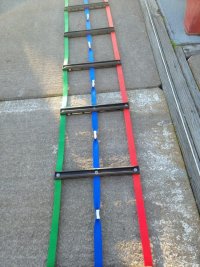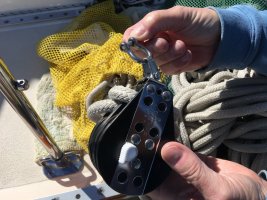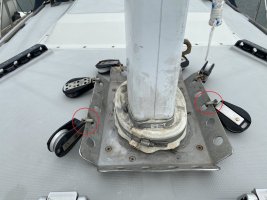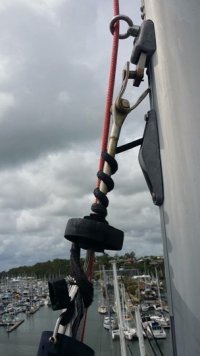Good Morning Mr. Tap,
I don't want to sound evasive, but it kind of depends on how you're approaching the issue. If it's just going up for the occasional inspection then a good bosun's chair is fine and a bit less expensive than a good harness. However, if you're looking for a bullet proof system that will allow you to work for any period of time, at any location on the mast or spreaders, you can't beat a harness system.
To stay with the harness, the most important thing is fit and comfort. It's not fun coming down from a relatively short time aloft and your legs are totally numb from a too tight or poorly supporting harness. When it fits properly, you should be able to hang upside down and have no fear of falling out. I've found the best resource for a good selection of harnesses , and other associated climbing gear is
www.wesspur.com If you know any professional riggers or tree care people in your area it doesn't hurt to see what they're using and maybe they'll let you try one on. Key features you should be looking for are wide, padded thigh loops, secondary tie in points and accessory loops to secure tools or gear bags. Wes Spur has a good video on selecting a harness and a ton of other great videos on techniques and equipment. Make certain you have some spare time when you go to their site, it's full of rabbit holes.
Once we start talking about methods to go aloft, how to stay up there, work safely and efficiently and come back down, the options are much more numerous. Again, it kind of depends on your reality. Are you looking for a system specific to your own boat? Are you looking for something that you can use for the yacht club friends to help them with projects? Since I do this for a living my setup, and accessories, allow me to work on anything from a Santana 22 to a 70ft Maxi.
The basic allowances are, IMO, that you can get to the masthead under your own power, get out to the ends of the spreaders, be able to ascend from either side of the mast, face or back, be able to secure yourself to the spar in case of a halyard failure and the ability to descend by yourself. There are other things that need to be addressed, like how to manage tools and equipment while you're up there, but that's another topic for discussion.
As I was discussing with Neil, I mostly use a 2:1 purchase system that I hoist aloft on a halyard. Obviously I inspect and load test the halyard before I go up on it. If it's unsafe, I carry a 200ft. length of 11mm Warpspeed 2, with reeving eyes spliced in each end, that I will replace the existing halyard with. The top block is a Harken single, ratcheting, with a becket; through which is reeved 300ft. of 7/16" Regatta Braid to the lower Harken single block. Note that Harken does not recommend using rigging blocks for life support, they have a specific product line for items that are fall rated. Also, when you look at arborist's equipment, their blocks meet specific requirements for load rating. I use the gear I do understanding the inherent risks, and I inspect everything thoroughly before each use. I also have a "rope walking" system that I've been playing with for a while and may transition to shortly. If you Google rope walking you'll find some pretty cool videos out there.
There are many ways to secure yourself once you get up there, again, peruse the Wes Spur site for equipment and videos. The main thing is that you are comfortable with, and fully know how to use whatever technique/equipment you choose. A tether from your harness, around the spar, and back to your harness is a minimum, and it must be able to support a fall. One short coming of using a spare halyard, secured by someone on deck, as a secondary safety, can be how it's tended during descent. Too many people overthink how to get up a mast, and put too little thought about how to get down. Coming down is usually more dangerous than going up, especially if you're not in control. I like the ratchet block aloft, with the friction of the Regatta line and the ratchet engaged, I can completely control my rate of descent. If I let go of the line completely I will come down fast, but probably not at a lethal rate. Some riggers I know use a ratchet block at both ends of the tackle (remember the advise from Harken here).
Anyway, this reply is getting pretty long. If someone with more knowledge of the system wants to make this a separate thread, that might be a good idea to allow it to carry on. I'm happy to keep the discussion going, as it can become rather lengthy and detailed. I hope something above helps.
Cheers
 WhatsApp Image 2021-02-10 at 5.13.54 PM.jpeg386.5 KB · Views: 58
WhatsApp Image 2021-02-10 at 5.13.54 PM.jpeg386.5 KB · Views: 58 WhatsApp Image 2021-02-10 at 5.13.53 PM.jpeg205.3 KB · Views: 57
WhatsApp Image 2021-02-10 at 5.13.53 PM.jpeg205.3 KB · Views: 57 WhatsApp Image 2021-02-10 at 5.13.52 PM.jpeg134.8 KB · Views: 57
WhatsApp Image 2021-02-10 at 5.13.52 PM.jpeg134.8 KB · Views: 57 WhatsApp Image 2021-02-10 at 5.13.55 PM (1).jpeg187.8 KB · Views: 57
WhatsApp Image 2021-02-10 at 5.13.55 PM (1).jpeg187.8 KB · Views: 57 WhatsApp Image 2021-02-10 at 5.13.55 PM.jpeg226.1 KB · Views: 58
WhatsApp Image 2021-02-10 at 5.13.55 PM.jpeg226.1 KB · Views: 58








